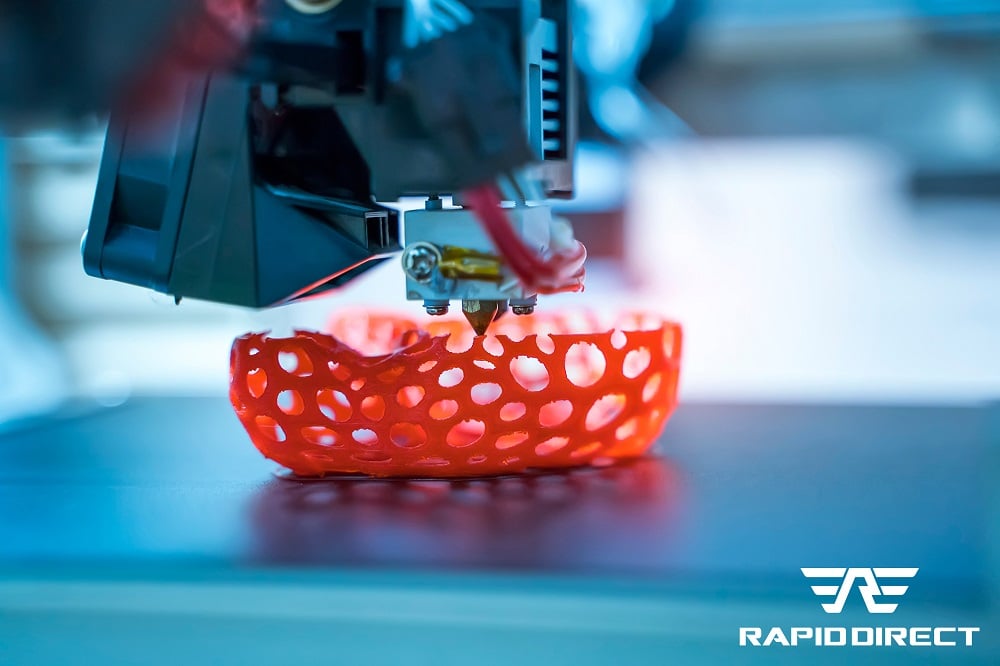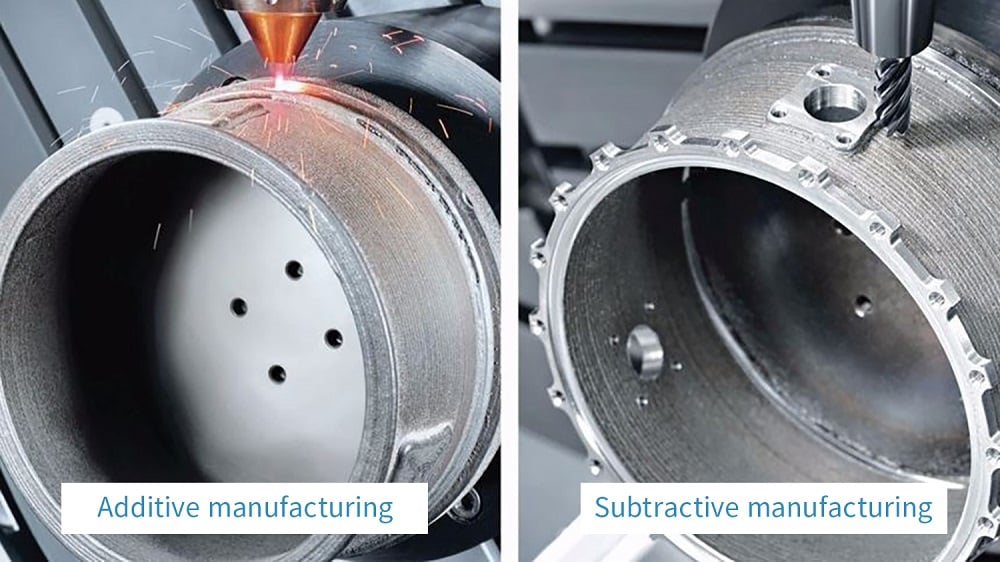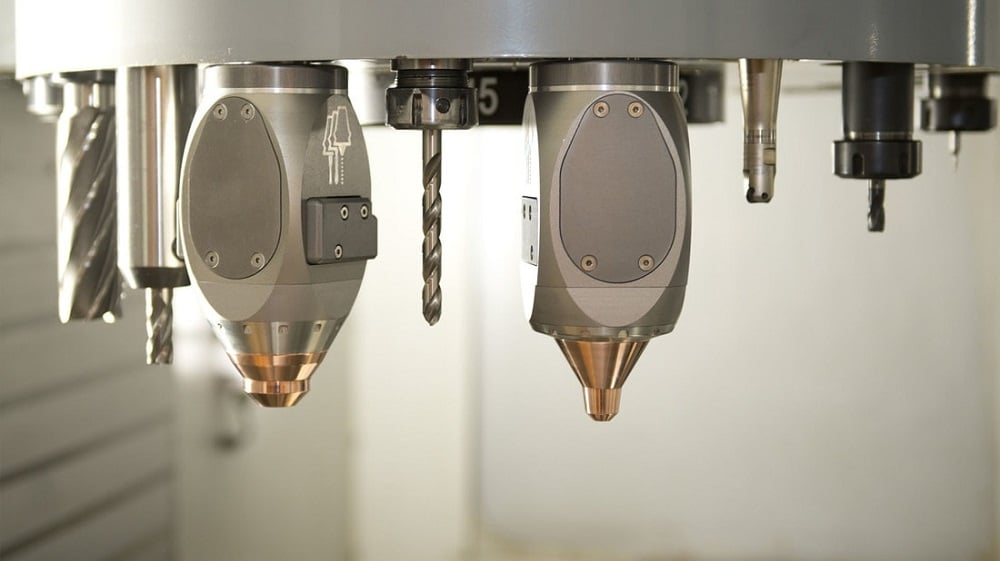There is an all too common belief that additive and subtractive manufacturing are wholly separate and even competing processes. This distinction is likely rooted in the marketing efforts of additive manufacturing companies that aim to promote 3D printing as a new and revolutionary manufacturing process that has advantages over more traditional, subtractive processes. In some cases, this claim is true. But it is much more valuable to look at how 3D printing is being used by manufacturers in various industries to complement existing manufacturing solutions.
In other words, let’s do away with the rhetoric of “out with the old and in with the new” and look at how new additive processes can bolster and improve existing subtractive manufacturing processes, like CNC machining.

Before we dive in, it is important to first consider the differences that do exist between additive and subtractive manufacturing—after all, they are completely different approaches.
Additive vs. Subtractive
In short, subtractive manufacturing consists of removing material from a block of raw material (whether metal or plastic) to obtain a final part. Subtractive processes can be conducted manually by cutting or drilling away at a material, but in industrial settings, they are usually performed by automated CNC machining or cutting systems.

Additive manufacturing, on the other hand, is an approach that has been around since the 1980s and consists of building shapes up in a layer-by-layer fashion. Today, there are various additive manufacturing processes for plastic (FDM, SLS, SLA, DLP, MJF, etc.) and metal materials (PBF, DMLM, DMLS, EBM, etc.). One of the main advantages of additive manufacturing is that it reduces material waste compared to subtractive processes.
In professional manufacturing environments, both subtractive and additive manufacturing processes create parts based off of a CAD design. Notably, both approaches are integrating increasingly sophisticated automation features, which facilitates the industrialization and scalability of the technologies.
Complementary Processes
Rather than looking at additive and subtractive manufacturing as two ends of the manufacturing spectrum, it is better to consider their respective strengths and weaknesses in order to leverage them both for optimized production. The two approaches actually fit together quite well for businesses seeking end-to-end industrial production.
For instance, while CNC machining is limited in terms of the geometries if can produce (especially undercuts and complex internal structures), 3D printing is highly suited for building parts with complex internal geometries. Similarly, 3D printing can produce hollow or partially hollow structures, enabling the production of lightweight parts.
On the other hand, CNC machining possesses certain qualities that additive manufacturing still lacks. If speed and large production volumes are required, CNC machining is much better for the job. CNC machining is also better suited for the production of large metal parts, while additive manufacturing would be the go-to process for a small, intricate component.
Both additive and subtractive processes are widely used for rapid prototyping—sometimes in combination. For instance, plastic 3D printing processes are economical and fast to use for the production of early-stage prototypes. As product development progresses—and especially if large batches or higher tolerance prototypes are required—subtractive processes can then be implemented.
For end-use parts, today’s manufacturing landscape is still dominated by subtractive processes, largely because of its speed and ability to produce strong, high tolerance parts. Still, additive manufacturing is increasingly being adopted for production purposes as the technology evolves. Presently, 3D printing is finding end-use applications for specialized or custom parts, as well as for small production runs.
Hybrid Manufacturing
Some machine producers have taken the combination of additive and subtractive processes to the next level by integrating them into a single machine. These machines, known as hybrid systems, can leverage the benefits of both manufacturing approaches.

Some hybrid systems build up a near-net structure using an additive approach and then introduce CNC machining to finish and polish the part, offering higher precision capabilities. Hybrid approaches are also creating opportunities for multi-material production.
Many hybrid systems are also well suited for the maintenance and repair of damaged parts, as material can be applied directly to the part using the additive approach and precisely finished using the subsequent machining tools.
RapidDirect’s Manufacturing Services
At RapidDirect, we offer a range of additive and subtractive manufacturing platforms, capable of fulfilling all kinds of projects. We offer numerous manufacturing platforms so that we can focus on finding the optimal manufacturing and rapid prototyping solution for each of our clients.
Our manufacturing experts work with our customers to determine the best course of action for a given product or part. Depending on the client’s requirements and the scale of the production, it often happens that 3D printing and CNC machining are used in harmony. Ultimately, the most important thing is the result, not the process.
—
This content is sponsored and the views and opinions expressed within it do not necessarily reflect All3DP’s editorial stance.
For more information, please see our Terms of Use.
License: The text of "Using Additive and Subtractive Manufacturing in Harmony" by All3DP is licensed under a Creative Commons Attribution 4.0 International License.